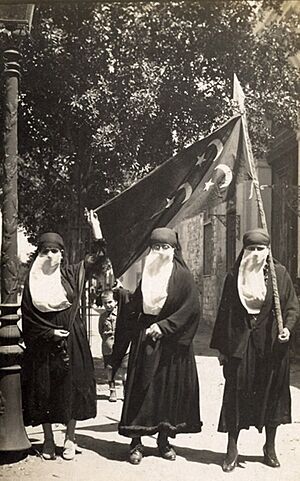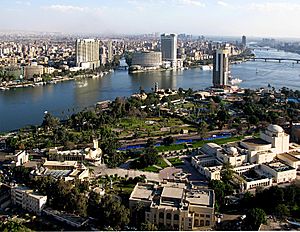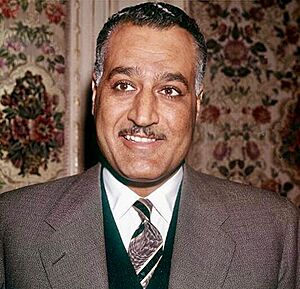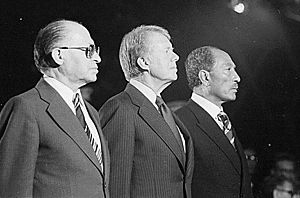History of modern Egypt facts for kids
The history of modern Egypt began in 1805 with the rule of Muhammad Ali. He started Egypt's journey to become a modern country. This included building a new army and changing the country's map. Some historians even say modern Egyptian history started earlier, around 1516, when the Ottomans defeated the Mamlūks.
Muhammad Ali's family became almost independent from Ottoman rule. This happened after his army campaigns. By 1882, Egypt, then called the Khedivate of Egypt, came under British influence. This was a bit confusing because Egypt was still officially part of the Ottoman Empire.
Egypt became a British protectorate in 1915. It gained full independence in 1922, becoming a kingdom. Muhammad Ali's family ruled until 1952.
Gamal Abdel Nasser ended the kingdom and started a republic in Egypt. This was after the 1952 Egyptian revolution. Egypt was then led by three presidents for about 60 years: Nasser (1954-1970), Anwar Sadat (1971-1981), and Hosni Mubarak (1981-2011).
In 2012, after a temporary government, elections were held. Mohamed Morsi became the first democratically elected leader in Egypt's history. However, in 2013, after large protests, the army removed Morsi. New elections led to Abdel Fattah El-Sisi becoming president.
Contents
British Control in Egypt
Growing Tensions and British Invasion
In 1882, many Egyptians were unhappy with European control. The army, led by Ahmed Urabi, was especially against it. In September 1881, a big army protest forced the Khedive Tewfiq (Egypt's ruler) to fire his Prime Minister.
In April 1882, France and the United Kingdom sent warships to Alexandria. They wanted to support the Khedive. This made many people in Egypt fear an invasion.
Khedive Tawfiq moved to Alexandria because he was worried about his safety. By June, Egyptian nationalists who opposed European rule were in control of the government. The British navy attacked Alexandria by sea. This did not stop the nationalists. So, in August 1882, a British army landed near the Suez Canal.
British Victory and Long-Term Plans
The British army defeated the Egyptian Army at the Battle of Tel el-Kebir in September. They took control of Egypt and put Khedive Tawfiq back in charge. The British had invaded to bring back political stability. They also wanted to fix Egypt's finances, which had been managed by international groups since 1876.
At first, the British probably did not plan to stay for a long time. However, Lord Cromer, Britain's main representative in Egypt, saw financial reforms as a long-term goal. He believed that Egypt needed stable finances for political stability. So, he started investing in Egypt's resources, especially cotton. Cotton was the main product Egypt sold to other countries.
In 1906, the Denshawai incident made people question British rule in Egypt. British control officially ended in 1914. Egypt became a protectorate, and Hussein Kamel became sultan. But British soldiers stayed in Egypt until June 1956.
Egypt as a Sultanate
World War I and Egyptian Independence
In 1914, World War I began. Britain declared war on the Ottoman Empire, which Egypt was still officially part of. Because of this, Britain declared Egypt a Protectorate. They removed the Khedive, Abbas Hilmi II, who was against Britain. His uncle, Husayn Kamel, became the Sultan of Egypt. Egypt then declared its independence from the Ottoman Empire.
The 1919 Revolution
A group called the Wafd Delegation went to the Paris Peace Conference of 1919. They demanded Egypt's full independence. Saad Zaghlul, a political leader who later became Prime Minister, was part of this group. When the British arrested and sent the group to Malta, a huge uprising happened in Egypt.

From March to April 1919, there were many large protests and uprisings. This event is known as the 1919 Egyptian revolution. Protests continued daily across Egypt for the rest of the spring. To the surprise of the British, Egyptian women also protested. They were led by Huda Sha‘rawi, who became a leading voice for women's rights in Egypt. The first women's protest was on March 16, 1919. Women continued to play a very important public role in the nationalist movement.
The British police first tried to stop the protests in Cairo. Soon, the Egyptian Expeditionary Force (EEF) troops took over. By the summer of 1919, most of the unrest was stopped. More than 800 Egyptians were killed. Also, 31 European civilians and 29 British soldiers died.
Attempts at a Treaty
In November 1919, the Milner Commission was sent to Egypt by the British. They wanted to find a solution. In 1920, Lord Milner suggested that the protectorate should be replaced by a treaty of alliance. As a result, Lord Curzon, the British Foreign Secretary, agreed to meet with an Egyptian group led by Zaghlul and Adli Pasha. They discussed the proposals and reached an agreement in August 1920.
In February 1921, the British Parliament approved the agreement. Egypt was asked to send another group to London to finalize a treaty. Adli Pasha led this group in June 1921. However, other British leaders wanted to keep control over the Suez Canal Zone. So, Curzon could not agree to the terms Adli Pasha wanted. The Egyptian group returned home disappointed.
The Kingdom of Egypt
Independence and Continued British Influence
In December 1921, the British in Cairo declared martial law. They deported Zaghlul again. This led to more protests and violence. Because of the growing desire for independence, the UK declared Egypt independent on February 28, 1922. Sultan Fuad I was then named King of Egypt.
However, Britain still had a lot of influence in the new Kingdom of Egypt. The British guided the king. They also kept control of the Suez Canal Zone, Sudan, and Egypt's foreign and military affairs.
King Farouk and World War II
King Fuad died in 1936. His son, King Farouk, became king at age sixteen. Farouk was worried when Italy invaded Ethiopia in the Second Italo-Abyssinian War. So, he signed the Anglo-Egyptian treaty. This treaty said Britain would remove all its troops from Egypt by 1949, except for those at the Suez Canal.
During World War II, British troops used Egypt as their main base for all Allied operations in the region. British troops moved to the Suez Canal area in 1947. But after the war, strong anti-British feelings continued to grow among Egyptians.
The Republic of Egypt
The 1952 Revolution and Nasser's Rise
From July 22-26, 1952, a group of army officers called the "free officers" overthrew King Farouk. They blamed the king for Egypt's poor performance in the 1948 war with Israel. The officers were led by Muhammad Naguib and Gamal Abdel Nasser. People hoped for quick changes. After a short period of civilian rule, the Free Officers ended the 1953 constitution. They declared Egypt a republic on June 18, 1953.
Nasser's Leadership
Nasser became a very popular leader, not just in Egypt but across the Arab world. He promoted "Arab socialism," which meant the government controlled many parts of the economy.
When the United States stopped selling military equipment to Egypt because of Egypt's neutral stance towards the Soviet Union, Nasser made an arms deal with Czechoslovakia in September 1955.
In 1956, the US and the World Bank stopped their offer to help pay for the Aswan High Dam. In response, Nasser took control of the Suez Canal Company, which was privately owned. This led to the Suez Crisis. France, Britain, and Israel invaded Egypt in October. This was also known as the Suez War.
United Arab Republic and Non-Alignment
In 1958, Egypt joined with Syria and the Gaza Strip to form a new state called the United Arab Republic. This union lasted until Syria left in 1961. However, Egypt continued to be known as the UAR until 1971.
Nasser also helped create the Non-Aligned Movement in September 1961. This group included developing countries that did not want to take sides with either the US or the Soviet Union. Nasser remained a key figure in this movement until his death.
Regional Actions and the Six-Day War
Nasser wanted to see a change in leadership in Yemen since 1957. In January 1962, he started supporting the Free Yemen Movement. He gave them office space, money, and radio time. Historians say Nasser wanted to regain his leadership in the Arab world after the union with Syria ended. He also wanted to remove British forces from South Yemen and its important port city of Aden.
Nasser ruled with strong control, but he was very popular in Egypt and the Arab world. People supported him because he stood up to Western powers and Israel. However, Nasser's independent foreign policy led to Israel launching the Six-Day War in 1967. In this war, the armies of Egypt, Syria, and Jordan were defeated by Israel.
After the war, Israel took control of the Sinai Peninsula and the Gaza Strip from Egypt. This defeat was a big blow to Nasser's reputation. After the loss, Nasser offered to resign, but he changed his mind after huge protests urged him to stay. The last three years of his rule were much quieter.
Sadat's Era: A New Direction
The Sadat era refers to the time when Anwar al-Sadat was president. This was from Nasser's death in 1970 until Sadat's assassination in 1981. Sadat changed Egypt's path in many ways. He moved away from Nasser's ideas. He became an ally of the United States instead of the Soviet Union. He started peace talks with Israel. He also brought back a system with multiple political parties and began new economic policies.
Shifting Away from Soviet Influence
After Nasser died, his Vice President, Anwar el-Sadat, became president. Many of Nasser's supporters thought Sadat would be easy to control. But Sadat had many changes planned for Egypt. He made smart political moves to start a "corrective revolution" in May 1971. This removed many strong Nasser supporters from the government and security groups. Sadat also allowed an Islamist movement, which Nasser had stopped, to grow. He believed Islamists were socially traditional, so he gave them freedom in culture and ideas in exchange for political support.
After the difficult Six-Day War in 1967, Egypt fought a War of Attrition in the Suez Canal area. In 1971, Sadat agreed to peace proposals from the UN. These proposals seemed to lead to full peace with Israel if Israel pulled back to its pre-war borders. But this peace plan failed because neither Israel nor the United States accepted the terms. To encourage Israel to negotiate and return the Sinai, and because the Soviets refused his requests for more military help, Sadat sent Soviet military advisors out of Egypt. He then prepared his army for another fight with Israel.
In the months before the 1973 war, Sadat worked hard diplomatically. By the fall of 1973, he had support for a war from over a hundred countries. This included most Arab League countries, the Non-Aligned Movement, and the Organization of African Unity. Syria agreed to join Egypt in attacking Israel.
In October 1973, Egypt's army crossed the Suez Canal and advanced about 15 kilometers. This put them within range of their own air force. After Syrian forces were pushed back, Syria asked Sadat to move his forces deeper into Sinai. Without air cover, the Egyptian army suffered huge losses. Despite these losses, they kept advancing. This created a gap in their forces. An Israeli tank division, led by Ariel Sharon, used this gap to reach Suez City. Meanwhile, the United States sent weapons and supplies to Israel and approved $2.2 billion in emergency aid. OPEC oil ministers, led by Saudi Arabia, responded by stopping oil sales to the US. The UN, with support from the US and the Soviet Union, called for an end to fighting and for peace talks. On March 4, 1974, Israel pulled its last troops from the west side of the Suez Canal. Twelve days later, Arab oil ministers ended the oil embargo against the United States. For Sadat and many Egyptians, the war felt more like a victory than a draw. They had achieved their military goal of gaining a foothold in the Sinai.
Closer Ties with the West
In foreign relations, Sadat made big changes. He shifted Egypt from fighting Israel to seeking peace through talks. After the Sinai Disengagement Agreements of 1974 and 1975, Sadat made a dramatic visit to Jerusalem in November 1977. This led to US President Jimmy Carter inviting Sadat and Israeli Prime Minister Begin for talks at Camp David.
The result was the historic Camp David accords, signed by Egypt and Israel on September 17, 1978. The accords led to the Egypt–Israel peace treaty on March 26, 1979. Through this treaty, Egypt got back control of the Sinai in May 1982. During this time, US–Egyptian relations got much better. Egypt became one of the largest receivers of foreign aid from America. However, Sadat's decision to make peace with Israel made most other Arab states angry. In 1977, Egypt fought a short border war with Libya.
Sadat used his great popularity to try to make big economic changes. He wanted to end the government control of the economy from the Nasser era. Sadat brought more political freedom and a new economic policy called infitah, or "open door." This policy reduced government control and encouraged private businesses to invest. While these changes created a wealthy upper class and a small middle class, they did not help the average Egyptian much. People started to become unhappy with Sadat's rule. In 1977, the infitah policies led to massive protests when the government announced it would stop helping pay for basic foods.
Sadat also brought back fair legal processes and banned torture. He broke up much of the old political system. He put many former government officials on trial for bad actions during Nasser's time. Sadat tried to let more people take part in politics in the mid-1970s, but he later stopped this effort. In his last years, Egypt faced violence from unhappiness with his rule and religious tensions. There was also more repression, including arrests without trial.
Changes with the Muslim Brotherhood
Another change Sadat made from Nasser's time was to allow more religious freedom. Sadat eased rules on the Muslim Brotherhood. He let them publish a monthly magazine, al-Dawa. This magazine was published regularly until September 1981.
In the late 1970s, Sadat started calling himself 'The Believer President.' He ordered Egypt's state TV to show the Salat (call to prayer) five times a day. He also increased religious programs. Under his rule, local officials banned alcohol sales in many areas, except for places serving foreign tourists.
Mubarak's Era
Becoming President and Foreign Policy
On October 6, 1981, President Sadat was assassinated by Islamic extremists. Hosni Mubarak, who had been Vice President since 1975, was elected president later that month. He was then confirmed by public vote for three more 6-year terms. The last one was in September 2005.
Mubarak continued Egypt's commitment to the Camp David peace process with Israel. At the same time, he brought Egypt back into a leading role among Arab nations. Egypt was allowed back into the Arab League in 1989. Egypt also played a calm role in international groups like the UN and the Nonaligned Movement.
Economic Changes and Political Challenges

From 1991, Mubarak started a big economic reform program. He wanted to reduce the government's role in the economy and increase the private sector. In the 1990s, agreements with the International Monetary Fund helped Egypt's economy. Also, Egypt received a lot of debt relief for its help in the Gulf War. Egypt's economy grew well in the 1990s and 2000s. The government brought inflation down from double digits to single digits. The average income per person, when adjusted for purchasing power, grew four times between 1981 and 2006.
There was less progress in political reform. In the November 2000 elections, 34 opposition members won seats in the 454-seat parliament. The ruling National Democratic Party (NDP) had a clear majority with 388 seats. In May 2005, a change was made to the constitution. It allowed more than one candidate to run for president. On September 7, Mubarak was elected for another six-year term with 87% of the vote. Ayman Nour, a leader of the opposition Ghad Party, came in second.
Soon after his presidential campaign, Nour was jailed on charges that critics said were fake. He was released in February 2009. Members of the Muslim Brotherhood were allowed to run for parliament in 2005 as independent candidates. They won 88 seats, or 20% of the parliament.
The opposition parties were weak and divided. They were not strong enough to be real alternatives to the NDP. The Muslim Brotherhood, founded in Egypt in 1928, was still an illegal group. It could not be recognized as a political party. However, its members were known and spoke their views openly. Members of the Brotherhood were elected to parliament and local councils as independents. Other opposition groups included Kefaya and the 6 April Youth Movement. Bloggers also played an important role in organizing public opposition.
Mubarak's Declining Influence
President Mubarak had strong, single-person control over Egypt. However, support for Mubarak and his economic reforms dropped sharply. News came out that his son Alaa was very corrupt. He was favored in government contracts and privatization deals. After 2000, Alaa started to step back. Mubarak's second son, Gamal, began to rise in the National Democratic Party. He brought a new generation of liberal thinkers into the party and eventually the government. Gamal Mubarak also started his own private equity fund and worked as a financial consultant.
Civil Unrest: 2011-2014
The 2011 Revolution
Starting on January 25, 2011, many street demonstrations and protests happened in Egypt. Organizers were inspired by the Tunisian uprising. The protests began because of police brutality, emergency laws, unemployment, low wages, lack of housing, rising food prices, corruption, lack of freedom of speech, and poor living conditions. The main goal of the protests was to remove President Hosni Mubarak.
On February 11, 2011, Mubarak resigned and left Cairo. Vice President Omar Suleiman announced that Mubarak had stepped down. The Egyptian military would take control of the country for a short time. People celebrated joyfully in Tahrir Square when they heard the news.
On February 13, 2011, the military announced that both the constitution and the parliament had been dissolved. A new parliamentary election was planned for September.
A vote on the constitution was held on March 19, 2011. On November 28, 2011, Egypt held its first parliamentary election since the old government. Many people voted. There were no reports of problems or violence.
A group was formed on March 26, 2012, to write a new constitution. Presidential elections were held from March to June 2012. The final vote was between former Prime Minister Ahmed Shafik and Muslim Brotherhood member Mohamed Morsi. On June 24, 2012, Egypt's election commission announced that Morsi had won. On June 30, 2012, Mohamed Morsi became Egypt’s new president.
Morsi's Presidency and Protests
On July 8, 2012, President Mohamed Morsi said he was canceling a military order that had dissolved parliament. He called lawmakers back into session.
On July 10, 2012, Egypt's highest court, the Supreme Constitutional Court of Egypt, canceled Morsi's decision to bring parliament back. On August 2, 2012, Egypt's Prime Minister Hisham Qandil announced his new cabinet. It had 35 members, including 28 new faces.
On November 22, 2012, President Mohamed Morsi issued a declaration. It said his decisions could not be challenged. It also aimed to protect the work of the group writing the new constitution. The declaration also called for new trials for those accused in the Mubarak-era killings of protesters. It extended the time for the constitution-writing group by two months. Morsi also said he could take any steps needed to protect the revolution.
Liberal and secular groups had left the constitution-writing group. They believed it would force strict Islamic practices. But Muslim Brotherhood supporters backed Morsi.
A vote on the constitution was held in two parts on December 15 and 22, 2012. It passed with 64% support. Morsi signed it into law on December 26, 2012.
This move was criticized by Mohamed ElBaradei, who said Morsi had taken all state powers. This led to large protests and violence across Egypt.
After Morsi's Removal
On June 30, 2013, on the first anniversary of Morsi's election, millions of protesters demanded his resignation. On July 1, the Egyptian Armed Forces gave political parties 48 hours to meet the people's demands. Morsi's presidency rejected the army's demand. He said he would follow his own plans for national reconciliation. On July 3, General Abdel Fattah el-Sisi, head of the army, announced that Morsi had been removed from power. He suspended the constitution and called for new presidential and parliamentary elections. He named Supreme Constitutional Court leader, Adly Mansour, as acting president. Mansour was sworn in on July 4, 2013.
In the months after the coup, a new constitution was prepared. It took effect on January 18, 2014. After that, presidential and parliamentary elections were to be held within six months.
El-Sisi's Presidency
In the elections of June 2014, El-Sisi won with 96.1% of the votes. On June 8, 2014, Abdel Fatah el-Sisi officially became Egypt's new president. Under President el-Sisi, Egypt has strictly controlled its border with the Gaza Strip. This includes taking down tunnels between Gaza and Sinai.
In April 2018, El-Sisi was re-elected by a large margin in the election. There was no real opposition. In April 2019, Egypt’s parliament extended presidential terms from four to six years. President Abdel Fattah al-Sisi was also allowed to run for a third term in the next election in 2024.
Under El-Sisi, Egypt is said to have returned to a more controlled style of government. New constitutional changes have been made. These changes strengthen the military's role and limit political opposition. The constitutional changes were approved in a vote in April 2019.
In December 2020, the final results of the parliamentary election showed a clear majority for Egypt’s Mostaqbal Watn (Nation’s Future) Party. This party strongly supports President El-Sisi. The party even gained more seats, partly because of new election rules.
See also
- History of Egypt
- Egyptian Constitution of 1923
- Liberalism in Egypt
- Terrorism in Egypt




